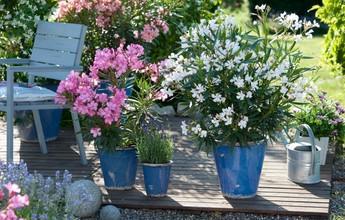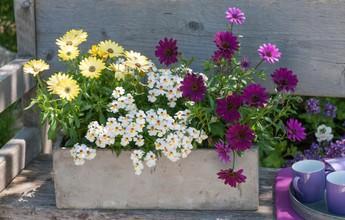
Never underestimate the power of a well-placed pelargonium in a terracotta pot. A dozen pink and scarlet market stall geraniums, placed at intervals along the edges of a balcony or courtyard boundary, will transform the landscape through summer and beyond. Given the huge choice of summer bedding available at this time of year, however, you might want to be more adventurous.
KEEPING IT GREEN
If you love houseplants in your home, for instance, then you can extend the landscape by featuring green foliage outside, too. Focus on large-leaved shrubs to make an impact: only two or three specimens are required, such as a Fatsia japonica, Mediterranean fan palm or even a paddle-leaved banana. Alternatively, bring a few houseplants outside for summer, which will give them a well-deserved holiday. Add highlights of colour to pop through the green with a few New Guinea busy lizzies. These headturners have larger, brighter flowers and darker, more exotic foliage than their English relatives. Nasturtiums, though a humble cottage garden flower, have just the right tropic vibe when left to scramble through foliage: just push two or three seeds here and there in the compost and watch the magic unfold.
DROUGHT-BUSTING BLOOMS
Facing the likelihood of another hot, dry summer, it makes sense to choose drought-resistant plants that won’t need twice-daily watering to keep them alive. Pelargoniums are top of the list, and so are oleander, trailing verbenas and the subtropical daisy flowers gazania and osteospermum, from palest lemon to a luscious velvety deep magenta. Even the white osteo boasts contrasting centres of navy blue. My vote for the drought-tolerant plant with the maximum petal power, however, has to be the salvia, aka flowering sage, in its many and glamorous guises. Salvias Amistad and guaranitica Black and Blue both have tall blackcurrant-tinted stems laden with purple flowers that keep on blooming from midsummer to late autumn, Cerro Potosi has dainty flower spires in the most intense shocking pink, Royal Bumble’s are bright flame while Salvia Hot Lips has distinctive two-tone scarlet and white lipped flowers. All salvias offer great value for very little upkeep.
HERO HERBS
The more familiar leafy sages to be found in the herb section of nursery or garden centre might be less showy but are equally indispensable. Purple-leaved sage makes a great contrast plant, but prettiest choice is the variegated, cream-edged sage that flatters every flower and won’t outgrow its space. Through a hot summer, it will produce sky blue blossom. All Mediterranean evergreen herbs – rosemary, sage, thyme, oregano – are the perfect foliage additions to every planting and, as their birthplace suggests, are used to drought conditions so need little watering. For a low-level, low-maintenance hedge along a balcony boundary, look no further than the free-flowering dwarf lavender Hidcote, which makes a superb scented border, year-round.


FLOWER PATCH IN A POT
There is some summer bedding, however, that is worth the cosseting, notably the much-loved sweet pea. The manual labour couldn’t be more pleasurable, though: all you need do is keep cutting them for more to appear, thus supplying you with scented sweet pea bunches for every room in your home. Traditional sweet peas, reaching 6ft or so, need support of some sort, but if there is none to hand, pick up a few pots of increasingly popular dwarf sweet peas that, with their short, strong stems but no compromise on flower or fragrance, are especially suited for containers and hanging baskets.
Free-flowering, generous cosmos will give you the feel of having a cut-flower patch despite the plant being restricted to a pot. Better make it a large one, though, to accommodate the mass of ferny foliage and endless supply of tall, airy stems topped with daisy blooms in the softest ice-cream pastels as well as pure white. Exceptionally, variety Cosmos Double Click Cranberries has furled petals of a deep, sultry garnet.
BE CONTAINER SAVVY
* Mixing water-retaining gel or granules into the compost at time of planting will help retain water, and so will a mulch: make it an attractive one by using Cotswold gravel, small pebbles or even shells.
* Buying smaller dot or plug plants early in the season is a real money saver, and at this time of year, they’ll put on quick growth and soon be full size.
* Drought-resistant plants hate sitting in wet, so as insurance, add a handful or two of horticultural grit or vermiculite in with the compost to keep it aerated. Raise pots off the ground with pot feet so any excess water can drain into a tray that can be emptied.
* Buying containers this season? Think inside the box: square and rectangular containers make a better use of space than circular pots. All garden centres supply square-cut terracotta planters and troughs which can be usefully pushed together to line a balcony or slot into a corner. Containers that have corners will also give plants more space in the compost to grow.
Photography: Friedrich Strauss/GAP PHOTOS